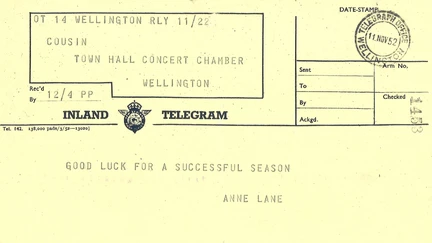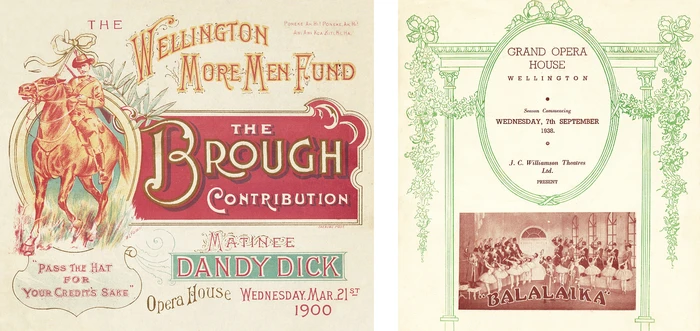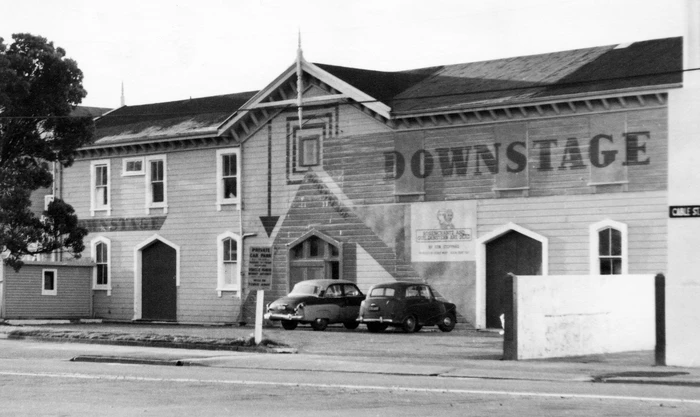One Hundred Years of Local Theatre
Theatre programmes and posters collected by the library over many decades are able to be rediscovered on Wellington City Recollect.

Posters which were once pinned to noticeboards in the 'old' (Mercer Street) Central Library have been kept for years in our local history collections, alongside ephemera donated to the Library by theatre-goers or performers. Our digitisation of a large portion of these has come to a close and over 700 items have been individually digitised and published on our heritage platform, Wellington City Recollect. The content spans from 1899 to 1999 and tells a story of its own: the role of early theatre in a growing city and how it evolved.

Theatre programmes for 'Dandy Dick' in 1900 and 'Balalaika' in 1938
Live theatre at the turn of the century was largely comprised of overseas touring groups brought in by companies such as J.C. Williamson who focused on existing European classics and Broadway successes. Performance halls matched the tone; the elegant Grand Opera House and His Majesty's Theatre were designed for modern conveniences that would be easily comparable to "the most up-to-date continental amusement houses". Attending such performances was a fashionable evening activity and the collectable programmes were littered with advertisements appealing to the upper class.
Locally-produced productions did feature on occasion and were often a fundraising or commemorative event; to farewell a prominent community member such as in 1899 or perhaps in support of the Boer War effort in 1900 (see "The Brough Contribution" above).
Back in England the British Drama League had already seen massive success in supporting local theatre and introduced a New Zealand Branch in 1932. It enabled small non-professional repertory groups to perform and compete with others in their regions and sometimes nationwide. It was also around this time that long-running groups (including the still-active Wellington Repertory Theatre) began producing their own renditions of well-known plays and musicals.
Active in the local theatre space were the Thespians with which Hataitai local Percy Cousins was heavily involved. Percy played the roles of actor, director, manager and even adjudicator for other organisations at times. It is thanks to his record-keeping that items such as photographs and telegrams are included in our Thespians and Peter Pan Players content.

Excerpts from a Wellington Repertory newsletter (1943) and a hand-drawn set design for the Thespians (1956)
Local theatre began to flourish and soon Downstage Theatre was founded as Wellington's first professional theatre. Both Downstage and Circa Theatre held their inaugural meetings at the Wellington Public Library and continued to use the community noticeboards within to post audition calls and advertise upcoming shows. The two groups elevated local theatre to higher ranks and began to introduce New Zealand and Australian plays to smaller, more intimate audiences; a stark contrast to the fanfare and extravagance brought by international actors just 50 years prior.
Downstage opened with Zoo Story at their leased site in Courtenay Place in 1964. Like other groups in the city they struggled with locating an appropriate permanent residence, eventually finding a temporary home at the Star Boating Club on Jervois Quay until the opening of the Hannah Playhouse in 1973. Draughty heritage buildings like the Star were often the only space available for local groups with small rent budgets; for some time Stagecraft Theatre occupied the former home of early European settlers Henry and Katy Tonks, carrying out extensive renovations to make the house fit for live performances.

Copyright held by Downstage Theatre
Amidst the success of these professional theatres, others saw a gap for amateur community groups and the 1970s and 80s saw the creation of the likes of BATS Theatre, The New Players, and The New Depot (later to become Taki Rua Productions). Red Mole was founded in 1974 by Alan Brunton, Sally Rodwell, and Jan Preston, who performed regularly at The Balcony (a nightclub also known as Carmen’s) and later reached international success. They presented Cabaret Capital Strut alongside other groups such as Chameleon at the Victoria Street location - now the site of Te Matapihi, our Central Library.
This more casual way of performing and watching theatre was a hit in Wellington, especially when the focus moved from European drama to New Zealand stories that audiences could relate to and interact with.

Flyers promoting "Red Mole and Friends: Stairway to the Stars" (1977) and Roger Hall's "Glide Time" at BATS Theatre (1983).
This changing landscape of live theatre is reflected in the style of published content produced. Early Opera House brochures are formulaic, remaining almost identical for twenty years save for the latest technology that was being advertised within (motor vehicles for the men, home appliances for women). Programmes start to get glossy and colourful in the '60s, as do the posters that were pasted on street corners and noticeboards. In parallel with this is a return to hand-drawn, low-cost publicity created by social activists supporting causes such as Stop the '81 Tour.
With a lot of advertising media now being produced and shared digitally, souvenirs from productions are becoming harder to collect (save from a screenshot of your Apple Wallet). Our theatre ephemera collection offers a glimpse of 20th Century Wellington and how we once consumed and interacted with live entertainment.